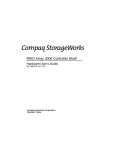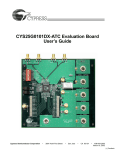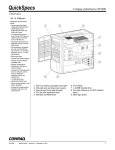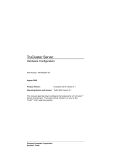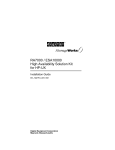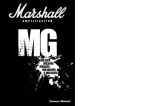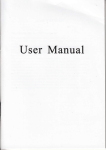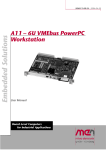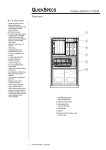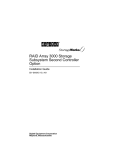Download Compex Systems SGX3226 Electronic Keyboard User Manual
Transcript
DWZZH 16–Bit UltraSCSI Hub (Rack-Mountable) User’s Guide EK–SMDZS-UG. B01 Compaq Computer Corporation Houston, Texas Second edition, November 1998 This equipment has been tested and found to comply with the limits for a Class B digital device, pursuant to Part 15 of the FCC rules. Operation is subject to the following two conditions: (1) This device may not cause harmful interference and (2) This device must accept any interference that may cause undesirable operation. This equipment generates, uses, and can radiate radio frequency energy and, if not installed and used in accordance with the instructions, may cause harmful interference to radio communications. However, there is no guarantee that interference will not occur in a particular installation. If this equipment does cause harmful interference to radio or television reception, which can be determined by turning the equipment off and on, the user is encouraged to try to correct the interference by one or more of the following measures: − Reorient or relocate the receiving antenna. − Increase the separation between the equipment and receiver. − Connect the equipment into an outlet on a circuit different from that to which the receiver is connected. − Consult the dealer or an experienced radio/TV technician for help. Japanese VCCI Statement Compaq Computer Corporation makes no representations that the use of its products in the manner described in this publication will not infringe on existing or future patent rights, nor do the descriptions contained in this publication imply the granting of licenses to make, use, or sell equipment or software in accordance with the description. Possession, use, or copying of the software described in this publication is authorized only pursuant to a valid written license from Compaq or an authorized sublicensor. The following are trademarks of Compaq Computer Corporation: Compaq, DEClaser, DIGITAL, OpenVMS, PATHWORKS, VAX DOCUMENT, and the Compaq logo. © Compaq Computer Corporation 1998. Printed in the United States of America All Rights Reserved Contents Revision Record…………………………………………………………………v About This Guide………………………………………………………….…..vii 1 Introducing the 16-Bit UltraSCSI Hub (Rack-Mountable) 1.1 UltraSCSI Hub Features.......................................................................................... 1–1 1.2 Product Descriptions............................................................................................... 1–2 1.2.1 DWZZH-S5 ...................................................................................................... 1–2 1.2.2 DWZZH-09 ...................................................................................................... 1–3 1.3 2 Product Specifications ............................................................................................ 1–4 Setting Up the DWZZH-09 2.1 Set Up DWZZH-09..................................................................................................2-1 2.1.1 Install 0.5m Cable in DWZZH-09......................................................................2-1 2.2 3 Configuration Note ................................................................................................. 2–4 Using the 16-Bit UltraSCSI Hub 3.1 Large Hub Fair Arbitration ..................................................................................... 3–1 3.2 Large Hub Addressing Configurations .................................................................... 3–2 3.2.1 Narrow Addressing Setting ............................................................................... 3–2 3.3 Front Panel ............................................................................................................. 3–4 3.3.1 Fair ARB Disable ............................................................................................. 3–6 3.3.2 Indicators.......................................................................................................... 3–6 4 3.4 Determining the Configuration ............................................................................... 3–8 3.5 Selecting the SCSI Cables....................................................................................... 3–8 Installing the DWZZH-09 Upgrade Kit 4.1 Install Upgrade ....................................................................................................... 4–2 4.1.1 Install 0.5m Cable............................................................................................. 4–2 5 SWCC and UltraSCSI Hubs 5.1 Agents and Storage ................................................................................................. 5–1 Appendix A Removable Parts of the DWZZH–S5 and DWZZH–09......A–1 Glossary.......................................................................................................G–1 EK-SMDZS-UG. B01 iii DWZZH 16-Bit UltraSCSI Hub (Rack-Mountable) Figures 1–1 DWZZH–S5 ........................................................................................................... 1–2 1–2 DWZZH–09............................................................................................................ 1–3 2–1 Attach Tri–Link to Cable ........................................................................................ 2–1 2–2 Install Tri–Link and Cable in Storage Ports of SBBs............................................... 2–2 2–3 A Sample Configuration ......................................................................................... 2–3 2–4 Maximum Allowable Cable Distances .................................................................... 2–4 3–1 DWZZH–S5 SCSI ID Assignments......................................................................... 3–3 3–2 DWZZH-09 SCSI ID Assignments ......................................................................... 3–4 3–3 DWZZH–S5 Front Panel......................................................................................... 3–5 3–4 DWZZH-09 Front Panel ......................................................................................... 3–6 3–5 DWZZH–S5 SCSI Narrow ID Assignments ............................................................ 3–7 3–6 DWZZH–S5 SCSI Narrow Addressing Jumper ....................................................... 3–8 4–1 DWZZH–09 Upgrade Kit Contents ......................................................................... 4–1 4–2 Install DWZZH–A5 SBB in Shelf ........................................................................... 4–2 4–3 Attach Tri–Link to Cable .........................................................................................4-3 4-4 Install Tri–Link and Cable in Storage Ports of SBBs................................................4-3 5-1 Running One SWCC Agent for a Particular Storage Subsystem ...............................5-2 A–1 Removable Parts of the DWZZH–S5 ..................................................................... A–2 A–2 Removable Parts of the DWZZH–09...................................................................... A–2 Tables 1–1 UltraSCSI Hub Functional Specifications ............................................................... 1–4 A–1 Removable Parts of the DWZZH–S5 ..................................................................... A–1 A–2 Removable Parts of the DWZZH–09...................................................................... A–1 iv EK-SMDZS-UG. B01 Revision Record The Revision Record provides a concise publication history of this guide. It lists the guide revision levels and release dates, and summarizes the changes. The following revision history lists all revisions of this publication and their effective dates. The publication part number is included in the Revision Level column, with the last entry denoting the latest revision. This publication supports the DWZZH 16-Bit UltraSCSI Bus Hub. Revision Level Date Summary of Changes EK–SMDZS–UG. A01 July 1998 Original Release. EK–SMDZS–UG.B01 October 1998 Change 1st sentence in section 3.3.3; move section 3.3.3 from pg.3-6 to pg. 3-2. EK–SMDZS–UG. B01 v About This Guide This chapter tells you what this User’s Guide does, identifies the audience, describes the structure and contents (chapter-by-chapter) briefly, and tells you how to get support and services from COMPAQ. This User’s Guide describes the purpose, function, operation, and use of the DWZZH 16-Bit UltraSCSI Rack-Mountable Hub (the DWZZH Hub or the Hub). The DWZZH Hub allows the connection of up to five ports on one logical SCSI bus on the DWZZH-S5 model and up to nine on the DWZZH-09 unit. Audience This guide is intended for end users and for COMPAQ employees responsible for configuring, installing, and maintaining the StorageWorks subsystem and its components. Related Documentation You should be familiar with the information contained in the following documentation: Document Title Order Number StorageWorks Solutions Configuration Guide EK–BA350–CG StorageWorks Solutions Shelf and SBB User’s Guide EK–BA350–UG StorageWorks SBB Shelf I/O Modules EK–SBBIO–UG StorageWorks UltraSCSI Configuration Guidelines EK–ULTRA–CG StorageWorks Solutions BA356–SB 16-bit Shelf User’s Guide EK–BA356–UG EK–SMDZS–UG. B01 vii DWZZH 16–Bit UltraSCSI Hub (Rack-Mountable) Shared Storage Solutions Using UltraSCSI Hubs EK-SMA21-AN Shared Storage for Windows NT Using UltraSCSI Hubs EK-SMA17-AN Shared Storage for OpenVMS Using UltraSCSI Hubs EK-SMA19-AN Shared Storage for DIGITAL UNIX Using UltraSCSI Hubs EK-SMA20-AN Shared Storage for Sun Solaris Using UltraSCSI Hubs EK-SMA18-AN Document Structure This guide contains the following chapters: Chapter 1. Introducing the 16-Bit UltraSCSI Hub (Rack-Mountable) This chapter gives brief functional and physical descriptions of the DWZZH Hub and lists significant product specifications. Chapter 2. Setting Up the DWZZH-09 This chapter gives instructions for installing the 0.5m cable on the DWZZH-09 Hub. Chapter 3. Using the 16-Bit UltraSCSI Hub This chapter gives procedures for configuring a StorageWorks SCSI bus using a DWZZH Hub. Chapter 4. Installing the DWZZH-09 Upgrade Kit This chapter gives instructions for installing the DWZZH-09 Upgrade Kit in a DWZZH-S5. Chapter 5. SWCC and UltraSCSI Hubs This chapter is intended to provide you with some important information regarding the use of StorageWorks Command Console (SWCC) on SCSI buses that have an UltraSCSI Hub. While the information provided here is important, it is essential that you have read the SWCC manual and release notes. Appendix A. Removable Parts of the DWZZH-S5 and DWZZH-09 This Appendix identifies the parts that can be removed and replaced from the DWZZH-S5/-09 16-Bit UltraSCSI Rack-Mountable Hubs. Glossary The Glossary defines terms that are used frequently with StorageWorks and SCSI bus components. viii EK–SMDZS–UG. B01 About This Guide Getting Help If you have a problem and have exhausted the information in this guide, you can get further information and other help in the following locations. Compaq Web Site The Compaq Web Site has information on this product as well as the latest drivers and Flash ROM images. You can access the Compaq Web Site by logging on to the Internet at http://www.compaq.com. Telephone Numbers For the name of your nearest Compaq Authorized Reseller: In the United States, call 1-800-345-1518 In Canada, call 1-800-263-5868 For Compaq technical support: In the United States and Canada, call 1-800-386-2172 EK–SMDZS–UG. B01 ix 1 Introducing the 16-Bit UltraSCSI Hub (Rack-Mountable) This chapter gives a brief physical description and describes the functions and functional specifications of the DWZZH-S5 and DWZZH-09 UltraSCSI Hubs. The series of DWZZH Hubs are SCSI–2 and draft SCSI–3 (ANSI X379.2/91– 10R3) compliant capable with data transfer rates of up to 40 Mbytes per second. The two versions of these Hubs are: 1.1 • DWZZH-S5: A shelf-contained, rack-mountable, 5.25" SBB (large) Hub with four host ports and one storage port, all differential. See Figure 1–1. • DWZZH-09: A shelf-contained, rack-mountable Hub consisting of two 5.25" SBBs (large) with eight host ports and one storage port, all differential. See Figure 1–2. UltraSCSI Hub Features Most device SCSI buses are either 8-bit or 16-bit single-ended, physical buses. Some controllers and hosts use differential buses and others use a single-ended bus. Single-ended and differential physical buses are not compatible. The UltraSCSI protocol disables both buses when they are connected together. By using an UltraSCSI Hub you can accomplish the following: • Provide radial disconnect where remaining connections can continue to operate. • Provide fair SCSI arbitration for host nodes (DWZZH-05, -S5 and the -09 UltraSCSI Hubs only). EK-SMDZS-UG. B01 1-1 DWZZH 16-Bit UltraSCSI HUB (Rack-Mountable) 1.2 Product Descriptions 1.2.1 DWZZH-S5 A DWZZH-S5 large UltraSCSI Hub (See Figure 1-1) consists of two 180W power supplies, three bulkhead covers, a personality card cover, and a DWZZH-05 SBB mounted within a shelf. This model is rack-mountable, in either a horizontal or vertical position. Termination is provided by each of the host ports. A feature of the DWZZH-S5 Hub is that it is upgradeable from a five port Hub to a nine port Hub with the purchase of a DWZZH-09 Upgrade Kit. The kit contains another 5.25" SBB (large) Hub (DWZZH-A5), a tri-link and 0.5m cable, and instructions to complete the installation, and configuration for the upgrade. CAUTION Connecting a single-ended bus cable to the differential connector causes the SCSI bus to fail. Figure 1–1 DWZZH–S5 1–2 EK–SMDZS–UG. B01 Chapter 1. Introducing the 16-Bit UltraSCSI Hub (Rack-Mountable) 1.2.2 DWZZH-09 The DWZZH-09 is made up of two large Hubs connected by a 0.5m VHDCI cable (BN 37A-0E). A tri-link attached to the DWZZH-A5 portion of the Hub allows the attachment of a storage device up to 25 meters away from the Hub. The Hub provides radial connectivity by allowing the user to connect up to eight host bus adapters from any number of distributed systems to the DWZZH-09. Termination is provided by each of the host ports. (See Figure 1-2.) Figure 1-2 DWZZH-09 S H R-11 05 EK–SMDZS–UG. B01 1–3 DWZZH 16-Bit UltraSCSI HUB (Rack-Mountable) 1.3 Product Specifications Table 1-1 lists the functional specifications for the DWZZH Hub. Table 1–1 UltraSCSI Hub Functional Specifications Feature SCSI ID SCSI Addresses Overload Protection DTERMPOWER STERMPOWER Shielding, Enclosure & Connectors Power-Up Reset SCSI Bus Reset Differential SCSI Bus Length Ultra (20 megatransfers per second or 40 MB/s) Data Timing Design 1–4 Specification The small UltraSCSI Hub does not use a SCSI ID. The large UltraSCSI Hub uses SCSI ID 7 for arbitration, when the fair arbitration option is enabled. TERMPOWER is not supplied by the UltraSCSI Hub. Internal TERMPOWER is protected via a resetable fuse. TERMPOWER must be supplied from the remote connection to enable each Hub port. Shielded for ESD, EMI, and safety requirements. Automatically clears: • Initiator detection circuit • Target detection circuit • BSY glitch filter Automatically clears: • Initiator detection circuit • Target detection circuit • BSY glitch filter 25 meters (82 feet) per segment. Refer to Chapter 2, Section 2.2 Configuration Note for more information regarding cabling distances. The relationship between the data and the control signals is brought to SCSI compatibility before transmission to the other SCSI bus. High reliability SMT EK–SMDZS–UG. B01 Chapter 1. Introducing the 16-Bit UltraSCSI Hub (Rack-Mountable) Table 1–1 DWZZH HUB Functional Specifications (Cont’d) Feature Cable Fault Glitch Elimination Specification DIFFSENSE support and port disable on cable fault. 100% glitch-free operation during power-up BUSY GLITCH trap eliminates cable length constraint due to wired-OR glitches on the BSY line. Termination Differential Termination for 16-bit operation. Service There are no user serviceable functions on these products. Contact Digital service personnel all service. Agency Approvals UL, CSA, FCC Class B, TUV Environmental Specifications Relative Humidity 10% to 85% non-condensing Operating Temperature 10°C to 40°C (50°F to 104°F) Storage Temperature (non–40°C to 66°C (–40°F to 151°F) operating) Power Requirements DWZZH +5V TERMPOWER Supplied to internal terminators only. SCSI Connectors and Cables Differential Board-mounted, 68-pin VHDCI SCSI connector Cables Refer to EK-ULTRA-CK.C01 UltraSCSI Configuration Guidelines. EK–SMDZS–UG. B01 1–5 2 Setting Up the DWZZH-09 This chapter gives instructions for setting up and configuring the DWZZH-09 Hub. 2.1 Set Up DWZZH-09 1. After removing the unit from the box, shipping material, and plastic bag, set it in a secure place or mount in a rack. 2. Remove the following parts from the shipping bag: • 0.5m Cable, P/N BN37A-0E • Tri-link NOTE If you do not have all of the above listed parts, contact your sales representative. 2.1.1 Install 0.5m Cable in DWZZH-09 1. Attach the 0.5m cable to the top port of the tri-link, refer to Figure 2-1. Figure 2-1 Attach Tri-link to Cable SH R-1109 EK–SMDZS–UG. B01 2–1 DWZZH 16–Bit UltraSCSI Hub (Rack-Mountable) 2. Install and secure tri-link in storage port of right-hand SBB (-A5). Then install and secure the opposite end of the cable in the storage port of the left hand SBB (-05), Figure 2-2. Figure 2-2 Install Tri-link and Cable in Storage Ports of SBBs SH R-111 0 3. 4. 5. 2–2 Install power cords in power supplies on unit. Attach the cables from your host bus adapters to their respective ports on the DS-DWZZH-09. Refer to Chapter 3, Figure 3-2 for the SCSI ID port assignments on the DS-DWZZH-09. Connect your storage subsystem via cable to the remaining port on the tri-link attached to the right-hand SBB of the DS-DWZZH-09. EK–SMDZS–UG. B01 Chapter 2. Setting Up the DWZZH-09 Figure 2–3 A Sample Configuration EK–SMDZS–UG. B01 2–3 DWZZH 16–Bit UltraSCSI Hub (Rack-Mountable) 2.2 Configuration Note According to the UltraSCSI Configuration Guidelines (included in your purchase), the maximum allowable cable distance for an UltraSCSI Domain is 74 meters. Each element, including the DWZZH-09 has an associated relative cable distance value associated. Cables count as their specified distance, (including the 0.5 meter jumper cable between the SBB Hubs); but each DWZZH SBB counts as an 18.5 meter cable equivalent. This means that communications from a server attached to the left-hand SBB to a server attached to the right-hand SBB, already has a 37.5 meter cable equivalent distance cost to propagate the signal through the DWZZH-09 Hub. Therefore, if the distance from server A to the Hub is X, and the distance from server B to the Hub is Y, then the sum cable distance of X and Y must be less than or equal to 36.5 meters (74 – 37.5). Please note that any SCSI transaction from a host to the storage subsystem only propagates through one of the SBBs. This means that you may still have a cable length of 25 meters between the storage subsystem and the DS-DWZZH-09. Refer to Figure 2–4. Figure 2–4 Maximum Allowable Cable Distances 2–4 EK–SMDZS–UG. B01 3 Using the 16-Bit UltraSCSI Hub This chapter discusses fair arbitration of the SCSI bus by the 5.25" SBB Hub. It describes addressing configurations, tells you how to use the large Hub front panel, and gives guidelines for selecting the SCSI cables. UltraSCSI configuration guidelines are documented in EK-ULTRA-CG. These guidelines include a list of all UltraSCSI components and the last few example configurations include an UltraSCSI Hub. Refer to the configuration guidelines for bus length and SCSI bus data transmission rates. 3.1 Large Hub Fair Arbitration The DWZZH-S5 and the DWZZH-09 can be operated with Fair Arbitration enabled or disabled. Although it is recommended that both be operated with Fair Arbitration enabled, it is not required. In order to allow four or more host SCSI IDs to participate on a single SCSI bus and to prevent lower SCSI host IDs from being starved for bus time, a fair arbitration (Fair ARB) scheme is employed. Fair ARB works by assigning SCSI ID 7, the highest priority ID to the Hub. When a SCSI arbitration phase occurs, all the arbitrating IDs are captured in a register. ID7 is reserved and may not be assigned to any SCSI device connected to the Ultra SCSI Hub, regardless of having FairARB enabled or disabled. CAUTION Most manufacturers ship Host Bus Adapters with a default SCSI ID of 7. Ensure that the ID is changed before establishing a connection betwen the adapter and the Hub. The winning ID for this group will be the highest priority ID and allowed bus privilege. After this ID has completed its transaction, the ID will be removed from the group and at the next arbitration phase, the remaining highest ID will be serviced. This will continue until all of the IDs in the group have been serviced once. All requests from IDs not contained in the register will be backed off using ID 7. EK–SMDZS–UG. B01 3–1 DWZZH 16–Bit UltraSCSI Hub (Rack-Mountable) After all the IDs in the group have been serviced, a new group of IDs will be captured at the next arbitration phase. The fair arbitration algorithm only applies to host port SCSI IDs as defined by the assignment in each configuration. CAUTION Running the UltraSCSI Hub under heavy I/O with Fair Arbitration disabled may result in SCSI bus starvation for hosts with low IDs. 3.2 Large Hub Addressing Configurations The large UltraSCSI Hub has a specific SCSI ID configuration. The SCSI IDs are assigned to specific physical locations in the Hub. This allows the fair arbitration logic in the Hub to correctly identify the SCSI IDs that are participating in a fair arbitration cycle. CAUTION The SCSI ID of the HOST adapter must correspond to the assigned ID of the Hub port, to which the host port adapter is connected. Mismatched SCSI IDs will cause the SCSI bus to hang. Figures 3-1 and 3-2 show the physical layout of the ports and their associated SCSI ID assignments on the DWZZH-S5 and DWZZH-09 Hubs. 3.2.1 Narrow Addressing Setting The large Hub can be used with SCSI bus architectures that are limited to eight ID assignments such as Digital Unix 4.x and earlier versions (Figure 3-5 shows narrow ID assignments). A jumper on the rear of the Hub (Figure 3-6) must be installed to make the Hub respond to SCSI IDs 3 – 0 on the host ports. It should be noted that the DWZZH-09 Hub cannot be put into a narrow addressing mode. 3–2 EK–SMDZS–UG. B01 Chapter 3. Using the 16-Bit UltraSCSI Hub Figure 3–1 DWZZH–S5 SCSI ID Assignments C on tro lle r P ort S C S I ID 6-0 H ost P ort S C S I ID 1 3 EK–SMDZS–UG. B01 H o st P o rt S C S I ID 15 H o st P o rt S C S I ID 1 4 H ost P ort S C S I ID 1 2 S H R -1 0 6 9 3–3 DWZZH 16–Bit UltraSCSI Hub (Rack-Mountable) Figure 3-2 DWZZH-09 SCSI ID Assignments Co n trolle r Port SC SI ID 6-0 H ost P ort SC SI ID 1 3 H os t Port S CSI ID 15 Hos t Port SC SI ID 14 Host Port SC SI ID 12 Hos t P ort SCSI ID 11 H o st Po rt SC SI ID 9 H ost Po rt SC SI ID 10 Ho st Po rt S CSI ID 8 S HR-1106 3.3 Front Panel Figures 3-3 and 3-4 show the location of the front panel controls and indicators for the DWZZH-S5 and the DWZZH-09 Hubs. The DWZZH-09 Hub has two SBBs with each SBB having a switch and LED indicator. NOTE It is recommended that the Fair Arbitration switch be set in identical positions on all Hubs residing on the same SCSI bus. 3–4 EK–SMDZS–UG. B01 Chapter 3. Using the 16-Bit UltraSCSI Hub NOTE The black part of the switch in Figure 3-3 indicates the position of the switch. Figure 3–3 DWZZH–S5 Front Panel Fa ir D isa ble P o w er B u sy S H R -10 7 0 EK–SMDZS–UG. B01 3–5 DWZZH 16–Bit UltraSCSI Hub (Rack-Mountable) Figure 3-4 DWZZH-09 Front Panel F a ir D is ab le Fa ir D is a ble P ow er Po w er B us y B us y S H R -1107 3.3.1 Fair ARB Disable The large Hub contains a switch on the front panel that allows the user to disable the Fair ARB feature of the Hub. When Fair ARB is disabled, the Hub services SCSI arbitration cycles in the conventional SCSI priority order. Host port SCSI ID assignments are not linked to the physical port location in the Hub when Fair ARB is disabled. 3.3.2 Indicators The large Hub has two indicators on the front panel. The green LED indicates that POWER is applied to the Hub, while the yellow LED indicates that the SCSI bus is BUSY. 3–6 EK–SMDZS–UG. B01 Chapter 3. Using the 16-Bit UltraSCSI Hub Figure 3–5 DWZZH–S5 SCSI Narrow ID Assignments C on tro lle r P o rt S C S I ID 6-4 H o st P o rt S C S I ID 1 EK–SMDZS–UG. B01 H ost P ort S C S I ID 3 H ost P ort S C S I ID 2 H o st P o rt S C S I ID 0 S H R -1 0 7 1 3–7 DWZZH 16–Bit UltraSCSI Hub (Rack-Mountable) Figure 3–6 DWZZH–S5 SCSI Narrow Addressing Jumper W1 (To enable narrow addressing mode, install a jumper at W1 3.4 Determining the Configuration The UltraSCSI Hub is used in end–bus SCSI bus configurations only. The SCSI bus segments require TERMPOWER supplied from the remote connection to enable the SCSI Hub port for that segment. Each port on the UltraSCSI Hub has its own terminators. All SCSI buses are terminated at the physical ends of the bus. This is true even when using a DWZZH UltraSCSI Hub. DWZZH UltraSCSI Hubs are factory set to terminate the SCSI bus. No user configuration of the SCSI terminators is required. 3.5 Selecting the SCSI Cables The StorageWorks Solutions UltraSCSI Configuration Guide describes SCSI cables in detail. When selecting a cable you must consider the cable connector clearance. Be sure to determine the type connector compatible with the controller connector. In some cases you must use a right–angle connector when connecting the cable to the Host Bus Adapter because there is not enough clearance to use a straight connector. 3–8 EK–SMDZS–UG. B01 4 Installing the DWZZH-09 Upgrade Kit This chapter gives instructions for installing a DWZZH-09 Upgrade Kit in a DWZZH-S5. It is possible to upgrade a DWZZH-S5, five port Hub to a DWZZH-09, with the purchase and installation of the DWZZH-09 Upgrade Kit. This kit contains (See Figure 4-1): • One DWZZH-A5 5.25" SBB • 0.5m Cable, BN37A-0E • Tri-link, H8861-AA • Bulkhead Cover Figure 4-1 DWZZH-09 Upgrade Kit Contents S H R -1113 EK–SMDZS–UG. B01 4–1 DWZZH 16-Bit UltraSCSI HUB (Rack-Mountable) NOTE If the kit that you received does not include all items listed above, contact your sales representative. 4.1 Install Upgrade 1. Remove DWZZH-A5 SBB from packaging. 2. Remove three bulkhead covers from the right-hand side of the DWZZH-S5 unit. 3. Slide the DWZZH-A5 SBB into the right-hand slots in shelf, where covers were just removed. See Figure 4-2. 4. Install personality card cover in unit. Figure 4-2 Install DWZZH-A5 SBB in Shelf SHR-1114 4.1.1 Install 0.5m Cable 1. 4–2 Attach the 0.5m cable to the top port on the tri-link, refer to Figure 4-3. EK–SMDZS–UG. B01 Chapter 4. Installing DWZZH-09 Upgrade Kit Figure 4-3 Attach Tri-link to Cable SH R-1109 2. Install and secure tri-link in storage port of right-hand SBB. Then install and secure the opposite end of the cable in the storage port of the left hand SBB, Figure 4-4. Figure 4-4 Install Tri-link and Cable in Storage Ports of SBBs SH R-1110 3. Install power cords in power supplies on unit. EK–SMDZS–UG. B01 4–3 5 SWCC and UltraSCSI Hubs This chapter is intended to provide you with important information regarding the use of StorageWorks Command Console on SCSI buses that have an UltraSCSI Hub. While the information provided here is important, it is essential that you have read the SWCC Manual and Release Notes. 5.1 Agents and Storage It is highly recommended that you only run one SWCC agent on one of the servers that can access a particular storage subsystem behind the DS-DWZZH-09 UltraSCSI Hub. Using SWCC through the client-agent model is very similar to using a serial terminal to access the HSZ-70 controller; running multiple agents to access one storage subsystem would show up as multiple storage windows on the SWCC-Client machine. This could be a potential problem, as the Client would see multiple HSZ-70 subsystems, when in fact, only one exists, but is being displayed multiple times. NOTE If you have multiple storage subsystems behind the DS-DWZZH UltraSCSI Hub, be sure to name each of your storage subsystems uniquely and carefully (when you configure SWCC) so that you can distinguish between them easily. The SWCC Graphical User Interface (GUI) neither displays when HSZ access ID restriction is being enforced nor prevents changes to restricted configurations from the GUI. For example, consider having four servers, each with a uniquely identified Host Bus Adapter attached to a DS-DWZZH 5-port UltraSCSI Hub, connected to a RA 7000 Subsystem with 24 disks (see Figure 5–1). Furthermore, consider the case where you have access ID restrictions configured such that each SCSI ID 12-15 could access a unique set of six disks in the storage cabinet. EK–SMDZS–UG. B01 5–1 DWZZH 16-Bit UltraSCSI HUB (Rack-Mountable) This type of configuration would prevent systems with different SCSI IDs from accessing disks ‘belonging to’ a particular SCSI ID, which promotes data security between servers on a shared SCSI bus; however, it does not prevent SWCC from performing tasks on those disks. In other words, if you set up the SWCC client to have configuration capability (see SWCC documentation) then you can access everything in the storage subsystem, regardless of HSZ-70 access ID restrictions. For further information on setting up and configuring agents on HSZ controllers, please see the SWCC and controller documentation. Figure 5-1 Running One SWCC Agent for a Particular Storage Subsystem 5–2 EK–SMDZS–UG. B01 A Removable Parts of the DWZZH-S5 and DWZZH-09 This Appendix identifies the parts that can be removed and replaced from the DWZZH-S5/-09 16-Bit UltraSCSI Rack-mountable Hubs. The following lists and illustrations identify the removable parts of the DWZZH-S5 and DWZZH-09 Hubs and are intended for reference purposes. See Figures A-1 and A-2. Table A-1 Removable Parts of the DWZZH-S5 Part Number DS-DWZZH-05 DS-BA35X-HH DS-BA356-SG Description UltraSCSI Hub Assy., 0SE & 5 Diff. Ports Power Supply, 180W, +5V, +12V 16-Bit Shelf Assy., w/FCC Mod’s, TG Blue Table A-2 Removable Parts of the DWZZH-09 Part Number DS-DWZZH-A5 DS-DWZZH-05 DS-BA35X-HH DS-BA356-SG H8861-AA BN37A-0E EK–SMDZS–UG. B01 Description UltraSCSI Hub Assy., 0SE & 5 Diff. Ports UltraSCSI Hub Assy., 0SE & 5 Diff. Ports Power Supply, 180W, + 5V, +12V 16-Bit Shelf Assy., w/FCC Mod’s., TG Blue VHDCI Tri-link 0.5 meter VHDCI male/male cable A–1 DWZZH 16–Bit UltraSCSI Hub (Rack-Mountable) Figure A-1 Removable Parts of the DWZZH-S5 S H R -1111 Figure A-2 Removable Parts of the DWZZH-09 S H R -111 2 A–2 EK–SMDZS–UG. B01 Glossary This Glossary includes an alphabetized listing and brief definition of the abbreviations, acronyms, COMPAQ-specific references, and other technical terms that are used in this manual and that may be unfamiliar to the reader. adapter See SCSI bus converter. building block shelf See SBB shelf. controller A hardware/firmware device that manages communications on behalf of host systems over the SCSI bus to devices, such as the HSC-series, HSJ-series, and HSZ-series controllers. Controllers typically differ by the type of interface to the host and provide functions beyond what the devices support. differential SCSI bus A signal's level is determined by the potential difference between two wires. A differential bus is more robust and less subject to electrical noise than is a single-ended bus. DWZZC A StorageWorks compatible 16-bit SCSI bus converter. See SCSI bus converter. DWZZH A StorageWorks compatible 16-bit UltraSCSI Hub. electrostatic discharge See ESD. ESD Electrostatic discharge is the discharge of a potentially harmful static electric voltage as a result of improper grounding. host The primary or controlling computer or any such unit (in a multiple computer network) to which storage is attached. EK–SMDZS–UG. B01 Glossary–1 DWZZH 16–Bit UltraSCSI Hub (Rack-Mountable) initiator A SCSI device that requests another device on the bus to perform an operation. Any device on the bus can be an initiator or a target. logical bus A single-ended, physical bus connected to a differential, physical bus by a SCSI bus converter. personality module The BA356 module that interfaces the SCSI-bus to the BA356 shelf. physical bus Two SCSI terminators separated by cables, connectors, and/or the backplane circuitry. SBB StorageWorks building block. The basic building block of the StorageWorks product line. Any device conforming to shelf mechanical and electrical standards installed in either a 3½-inch or 5¼-inch carrier is considered to be an SBB, whether it is a storage device, a power supply, or other device. SBB shelf The common name for any StorageWorks shelf that contains only power supply and storage SBBs. SCSI Small Computer System Interface. This ANSI interface defines the physical and electrical parameters of a parallel I/O bus used to connect computers and devices. The StorageWorks subsystem implementation uses SCSI–2 for the transfer of data. SCSI bus converter Sometimes referred to as an adapter. (1) A connecting device that permits the attachment of accessories or provides the capability to mount or link units. (2) The device that connects a differential SCSI bus to a single-ended SCSI bus. SCSI device A host computer adapter, a peripheral controller, or an intelligent peripheral that can be attached to the SCSI bus. SCSI device ID The bit-significant, representation of the SCSI addressing referring to one of the signal lines numbered 0 through 15. Also referred to as target ID. For example, SCSI device ID 1 would be represented as 00001. SCSI mid-bus position The physical location of a controller or a device that the SCSI bus passes through enroute to the controller or device that contains the SCSI bus termination. Glossary–2 EK–SMDZS–UG. B01 Glossary SCSI cable A 68-conductor (34 twisted pairs) cable used for differential bus connections. single-ended SCSI bus A bus in which each signal’s logic level is determined by the voltage of a single wire in relation to ground. Small Computer System Interface See SCSI. StorageWorks The Compaq set of enclosure products that allows customers to design and configure their own storage subsystem. Components include power, packaging, and interconnections in a StorageWorks shelf. SBBs and array controllers are integrated therein to form level enclosures to house the shelves. Standard mounting devices for SBBs are also included. StorageWorks building block See SBB. target A SCSI device that performs an operation requested by an initiator. Any device on the bus can be an initiator or a target. target ID See SCSI device ID. termpower Is an electrical current that is limited by self-resetting fuses. UltraSCSI Is an improvement in SCSI technology that was developed by the StorageWorks Engineering Group at Compaq Computer Corporation , and subsequently standardized by the ANSI SCSI committee (X3T10), which increases the maximum transfer rate on the SCSI bus from 10 MHz to 20 MHz (for a Wide SCSI bus this means an increase in maximum bus bandwidth from 20 MB/sec to 40 MB/sec). EK–SMDZS–UG. B01 Glossary–3









































